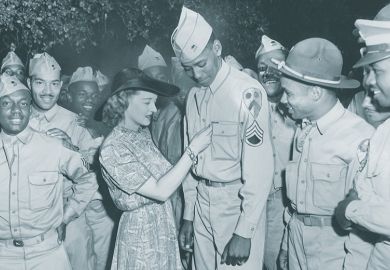It may be unwise to judge a book by its cover, especially since publishers' caution over copyright often thwarts authorial ambition, but in the case of Richard Dyer's Pastiche , a still from Todd Haynes's Far from Heaven seems to say it all, nearly. The film will form part of Dyer's final chapter, in which he confesses that the film initially moved him to tears and then argues that Haynes's pastiche of 1950s melodrama, specifically of Douglas Sirk's glossy All That Heaven Allows , allows us to imagine the repressive climate of that period and also to feel "the epistemological difficulty of such imagining".
It is a sophisticated argument, and one that Dyer admits not everyone will accept. But it is an argument eloquently expressed, and what is attractive about the book is its rare willingness to stake a series of claims about the quality of aesthetic experience. Even more unusually, these are not confined to film but reach out to music and particularly literature, with substantial discussion of Tchaikovsky, Hamlet , Proust and Flaubert.
I say "useful", because Dyer offers much patient definition and ground-clearing, distinguishing no fewer than 13 senses in which the word "pastiche" has been used, and examining ten ways in which it serves as the basis of artworks - all of which may recall such taxonomic classics as William Empson's Seven Types of Ambiguity or Wayne Booth's The Rhetoric of Fiction .
Indeed, there is an almost old-fashioned desire to parse and to clarify, far removed from the rhapsodic mystification still prevalent in some film-studies texts; and another more relevant comparison might be with Robert Stam's pioneering Reflexivity in Film and Literature . Like Stam, Dyer wants to reach out beyond the ghetto that film studies has largely become and to reinstate our response to films based on pastiche alongside our response to great, and sometimes merely pleasurable, art of other kinds.
So what is pastiche? In essence, it remains what we might assume: the knowing allusion to, or invocation of, previous works, so that our response is, as it were, mediated or qualified by awareness of what lies behind.
While this may be a defining feature of camp art, it is also much more pervasive. Indeed, there is a danger that almost all art may be categorised as imitative or parodic to some degree.
But Dyer is concerned centrally with those types of work where a balance of awareness is maintained, where there is "distance" - and there is no better example than the genre of the western.
Westerns, famously, have been hybridising since at least the 1940s, importing elements from other genres and exporting their trademark settings and characters into exotic locales. Not surprisingly, the spaghetti western claims Dyer's attention, with its elaborate hyperbole of the "traditional" genre. So, too, does the "female western". Discussion of these allows Dyer to explore the concept of masquerade and also of how pastiche can be cultural resistance to a default position, namely that the western is intrinsically male.
It may be truer, however, to argue that the western tradition as a whole is built upon pastiche - in that there is no authentic "original", merely a succession of variations on a theme.
Here, as in his discussion of "neo-noir" and even of Citizen Kane , with its elaborate pastiches of newsreel, tabloid journalism and grand opera, Dyer is consistently stimulating and suggestive, in a slim book that opens up a vast terrain.
Ian Christie is professor of film and media history, Birkbeck, University of London.
Pastiche
Author - Richard Dyer
Publisher - Routledge
Pages - 222
Price - £60.00 and £16.99
ISBN - 0 415 34009 8 and 34010 1
Register to continue
Why register?
- Registration is free and only takes a moment
- Once registered, you can read 3 articles a month
- Sign up for our newsletter
Subscribe
Or subscribe for unlimited access to:
- Unlimited access to news, views, insights & reviews
- Digital editions
- Digital access to THE’s university and college rankings analysis
Already registered or a current subscriber? Login



